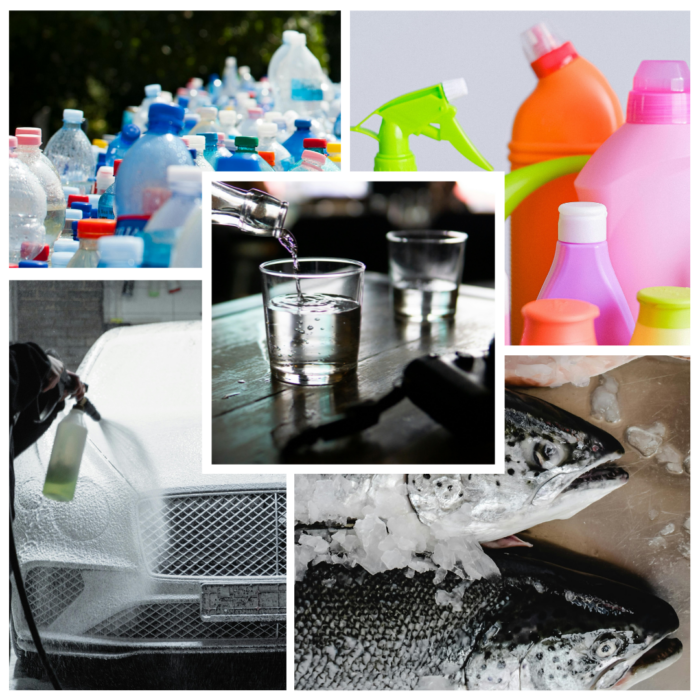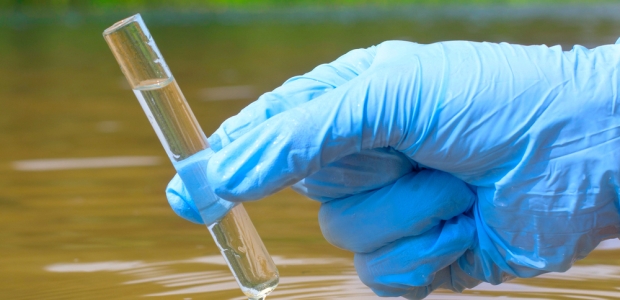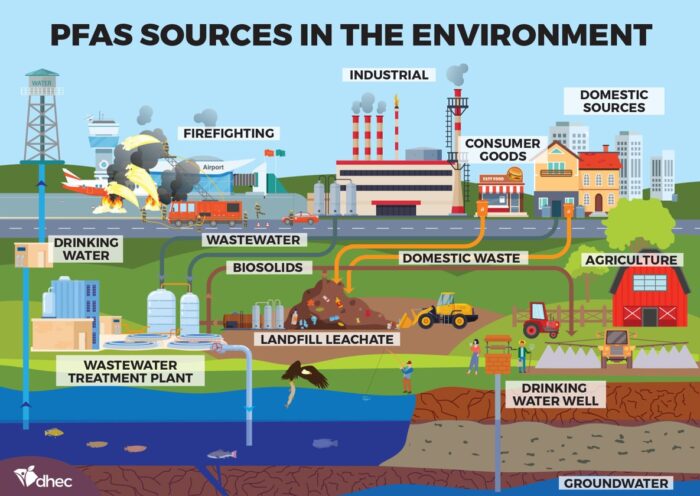EnviroScience toxicology experts have been closely tracking developments related to per- and polyfluoroalkyl chemicals (PFAS) and their implications for our clients. Our team of experts can help you navigate the rapidly changing regulatory and analytical climate to confirm compliance, saving you time and money by ensuring you get it right the first time.
What are PFAS?
Invented in the 1930s, PFAS comprise a group of thousands of widely used manmade chemicals—including PFOA, PFOS, GenX, PFBS, PFHxS, and PFNA—that do not break down under normal environmental conditions. Commonly referred to as “Forever Chemicals,” these chemicals remain in the environment and can accumulate in humans and animals. Adverse human health effects such as liver and kidney cancers, as well as thyroid, reproductive, and developmental effects, have been linked to exposure to PFAS.
Major sources of contamination in our air, drinking water, groundwater, and soil can be attributed to manufacturing plants, firefighting foams, industrial facilities, landfills, and wastewater treatment plants. However, these “Forever Chemicals” are found in a wide range of consumer products that people use daily, such as stain repellants, nonstick cookware, food wrappers, and an array of personal care products.

PFAS have been manufactured and used in the United States and around the world since the 1940s by various industries. Two of the most widely used and studied PFAS are PFOA and PFOS; however, both have been voluntarily phased out of production by their manufacturers.
As a result of actions taken under the Toxics Substance Control Act (TSCA), certain PFAS are no longer manufactured in the U.S. However, they are still produced internationally and can be imported to the U.S. in consumer goods such as rubber, textiles, carpet, leather and apparel, paper and packaging, coatings, and plastics.
Where are PFAS found?
According to the U.S. Environmental Protection Agency (USEPA), PFAS can be found in:
- Food packaged in PFAS-containing materials, processed with equipment that uses PFAS, or grown in PFAS-contaminated soil, compost, or water.
- Commercial household products, including stain- and water-repellent fabrics, nonstick products (e.g., Teflon™), polishes, waxes, paints, cleaning products, and aqueous film-forming foams (AFFF).
- Workplaces, including production facilities or industries (e.g., metal finishing and plating, textile mills, electronics manufacturing, and others).
- Publicly Owned Treatment Works (POTWs) receiving wastewater from residential communities; some POTWs can have a significant influence from industrial users (who may use PFAS in their production processes).
- Landfills, sanitary and/or construction and demolition (C&D) have the potential to receive solid waste that was manufactured with PFAS.
- Living organisms, including fish, animals, and humans, where PFAS bioaccumulate and persist over time.

PFAS Legislation
Since the release of the USEPA’s PFAS Strategic Roadmap in October 2021, the agency has been making progress in addressing PFAS in air, land, and water. As more research is performed on PFAS, we should expect these data to support future regulations and actions on limiting their release into the environment. Below is a brief timeline of some important updates from the USEPA.
- GenX Human Health Toxicity Assessment released – Oct 2021
- Finalized UCMR 5 Rule – Dec 2021
- Draft Aquatic Life Ambient Water Quality Criteria PFOA/PFOS – May 2022
- PFAS Drinking Water Health Advisories – Jun 2022
- PFBA Human Health Toxicity Assessment released – Dec 2022
- EPA Issues Guidance to States to Reduce Harmful PFAS Pollution NPDES – Dec 2022
- Effluent Guidelines (ELGs) Program (Plan 15) – Jan 2023
- Proposed Drinking Water MCLs PFOA/PFOS and four other PFAS – Mar 2023
- Proposed rulemaking CERCLA – PFOA and PFOS, and ANPRM 7 other PFAS – Apr 2023
- TSCA – Oct 2023
- Toxics Release Inventory (TRI) – Oct 2023
- TRI added 7 additional PFAS, total 196 – Jan 2024
- Method EPA 1633 and Method 1621 released – Jan 2024
- Proposed Rulemaking RCRA (9 PFAS as hazardous substances) – Feb 2024
Analytical Methods
Several methods are in use by analytical laboratories across the country, and it is important to ensure that the PFAS method your lab offers is appropriate for the matrix you are testing. Currently, there are two approved USEPA methods for PFAS compounds in drinking water. These methods are EPA 537.1 and EPA 533, and these methods report 18 compounds and 25 compounds, respectively. Both PFAS drinking water methods are being used by the USEPA in the Unregulated Contaminant Monitoring Rule 5 (UCMR 5) and will report a total of 29 PFAS compounds.
 Method 1633 was released in early 2024 and was developed for eight matrices (wastewater, surface water, groundwater, landfill leachate, soil, sludge, biosolids, and biota). Method 1633 can report a total of 40 PFAS compounds in parts per trillion (ng/L) for aqueous matrices and parts per billion (µg/kg) for solid matrices. Method 1621 Adsorbable Organic Fluorine (AOF) quantifies the organic fluorine concentration that adsorbs onto granular activated carbon.
Method 1633 was released in early 2024 and was developed for eight matrices (wastewater, surface water, groundwater, landfill leachate, soil, sludge, biosolids, and biota). Method 1633 can report a total of 40 PFAS compounds in parts per trillion (ng/L) for aqueous matrices and parts per billion (µg/kg) for solid matrices. Method 1621 Adsorbable Organic Fluorine (AOF) quantifies the organic fluorine concentration that adsorbs onto granular activated carbon.
Both methods are being recommended by the USEPA to be used for National Pollutant Discharge Elimination System (NPDES) permit holders that have PFAS testing requirements. Most PFAS laboratories have a 537M method, which is a modified method that has been used to measure PFAS compounds in non-potable water, solids, and biota. Laboratories will vary with their reporting limits and compound lists.
EPA 8327 and ASTM D8421 are two other methods available for non-potable water and solid matrices. These methods are direct injection methods and do not have the expanded QC requirements that are written in Method 1633. These methods can report up to 44 compounds and can have a faster turn-around time.
The Total Oxidizable Precursor (TOP) Assay is another method that can be used to measure the concentration of PFAS precursor compounds that can degrade into more terminal (persistent) PFAS compounds under oxidizing conditions found in water, sediments, soils, and biosolids. TOP Assay methods are evolving and can be run by Method 1633 and 537M. Assessment of TOP Assay data can be used to improve your understanding of potential PFAS environmental risk in a number of scenarios.
PFAS Sampling
 Field sampling for PFAS, regardless of matrix, has very restrictive requirements. Across the different matrices, EnviroScience experts know it is imperative to pay attention to what they have in their possession when collecting a sample. PFAS can be found in many of the personal care products, food containers, automotive seats, clothing, and other daily used consumer products. We know how important it is to consider and incorporate field quality control samples (field blanks, equipment blanks, and trip blanks) into sampling plans due to the ubiquitous nature of PFAS and the very low analytical detection limits (ppt). These field quality control samples will help determine if cross-contamination occurred from the sampler/sampling event, equipment, or transit of samples to the lab. EnviroScience can help you develop a site-specific protocol to assure compliance with state guidelines and that contamination does not occur.
Field sampling for PFAS, regardless of matrix, has very restrictive requirements. Across the different matrices, EnviroScience experts know it is imperative to pay attention to what they have in their possession when collecting a sample. PFAS can be found in many of the personal care products, food containers, automotive seats, clothing, and other daily used consumer products. We know how important it is to consider and incorporate field quality control samples (field blanks, equipment blanks, and trip blanks) into sampling plans due to the ubiquitous nature of PFAS and the very low analytical detection limits (ppt). These field quality control samples will help determine if cross-contamination occurred from the sampler/sampling event, equipment, or transit of samples to the lab. EnviroScience can help you develop a site-specific protocol to assure compliance with state guidelines and that contamination does not occur.
Mitigation
 Due to the unique chemistry of PFAS compounds (carbon-fluorine bonds), many standard remedial techniques are not effective. Currently, treatment options include soil incineration, excavation, and groundwater extraction, followed by treatment with activated carbon or ion-exchange resins. Research is ongoing to determine effective means of remediating these compounds, and destruction technology is showing promise in the ability to break the carbon-fluorine bond. EnviroScience professionals are monitoring the research and are aware of the latest and best treatment options in all media. We can help you properly select, design, implement, and monitor an effective remedial approach.
Due to the unique chemistry of PFAS compounds (carbon-fluorine bonds), many standard remedial techniques are not effective. Currently, treatment options include soil incineration, excavation, and groundwater extraction, followed by treatment with activated carbon or ion-exchange resins. Research is ongoing to determine effective means of remediating these compounds, and destruction technology is showing promise in the ability to break the carbon-fluorine bond. EnviroScience professionals are monitoring the research and are aware of the latest and best treatment options in all media. We can help you properly select, design, implement, and monitor an effective remedial approach.
Risk Assessment
EnviroScience can support our clients who are evaluating potential risks and/or requirements associated with PFAS compounds and the pending legislation. We can also assist with appropriate sampling plans, receptor and matrix testing, data analysis, and mitigation technologies.
For more information about how EnviroScience’s toxicology experts and our PFAS-related services, please contact our Senior Environmental Toxicologist, Kevin Custer, Ph.D.

Everyday sources of PFAS that contribute to human exposure. Source: SCDHEC
Few environmental firms in the country retain EnviroScience’s degree of scientific know-how, talent, and capability under one roof. The diverse backgrounds of our biologists, environmental engineers, scientists, and divers enable us to provide comprehensive in-house services and an integrated approach to solving environmental challenges—saving clients time, reducing costs, and ensuring high-quality results.
Our client guarantee is to provide “Excellence in Any Environment,” meaning no matter what we do, we will deliver on our Core Values of respect, client advocacy, quality work, accountability, teamwork, and safety. EnviroScience was created with the concept that we could solve complex problems by empowering great people. This concept still holds true today as our scientists explore the latest environmental legislation and regulations and incorporate the most up-to-date technology to gather and report data.
EnviroScience expertise includes but is not limited to aquatic surveys (including macroinvertebrate surveys and biological assessments); ecological restoration; ecological services (including impact assessments, invasive species control, and water quality monitoring); emergency response; engineering and compliance services; endangered mussel surveys; laboratory and analysis; stormwater management; threatened and endangered species; and wetlands and streams (including delineation and mitigation). Further, EnviroScience is one of the few biological firms in the country that is a general member of the Association of Diving Contractors International (ADCI) and offers full-service commercial diving services.



